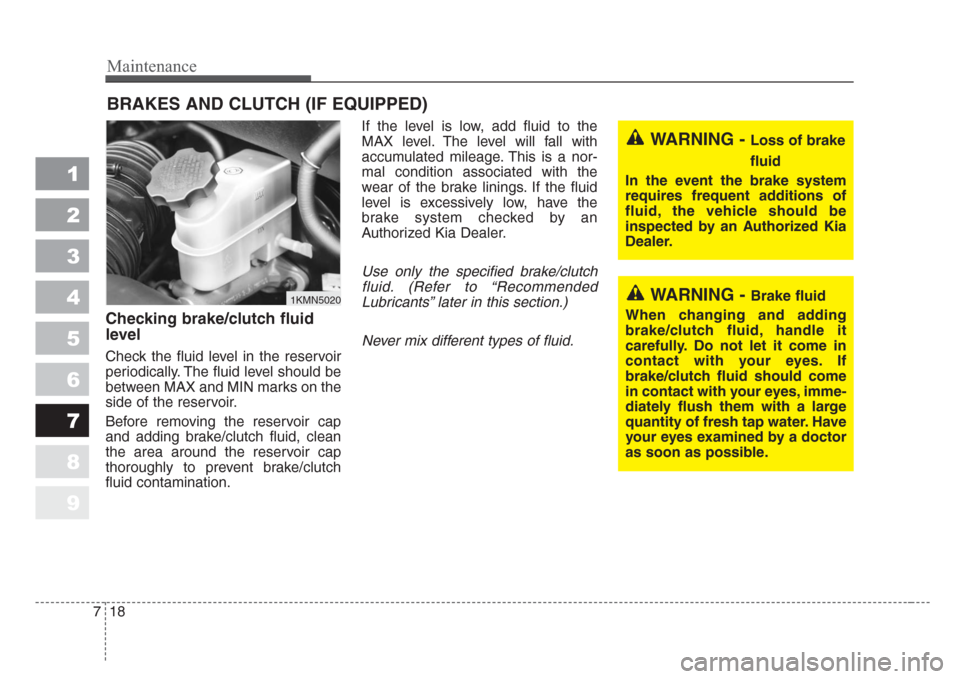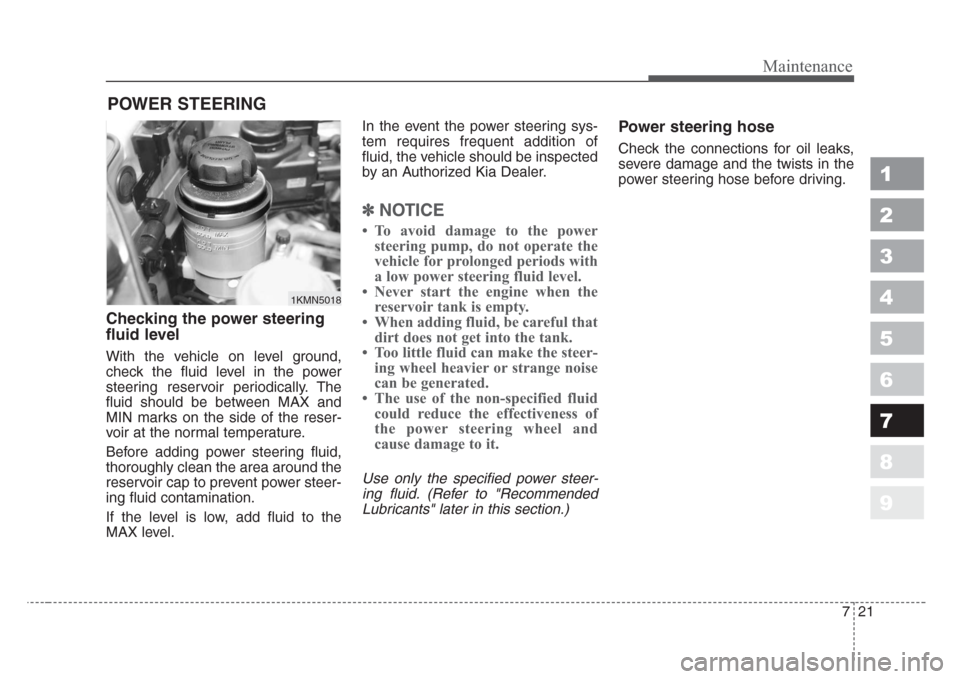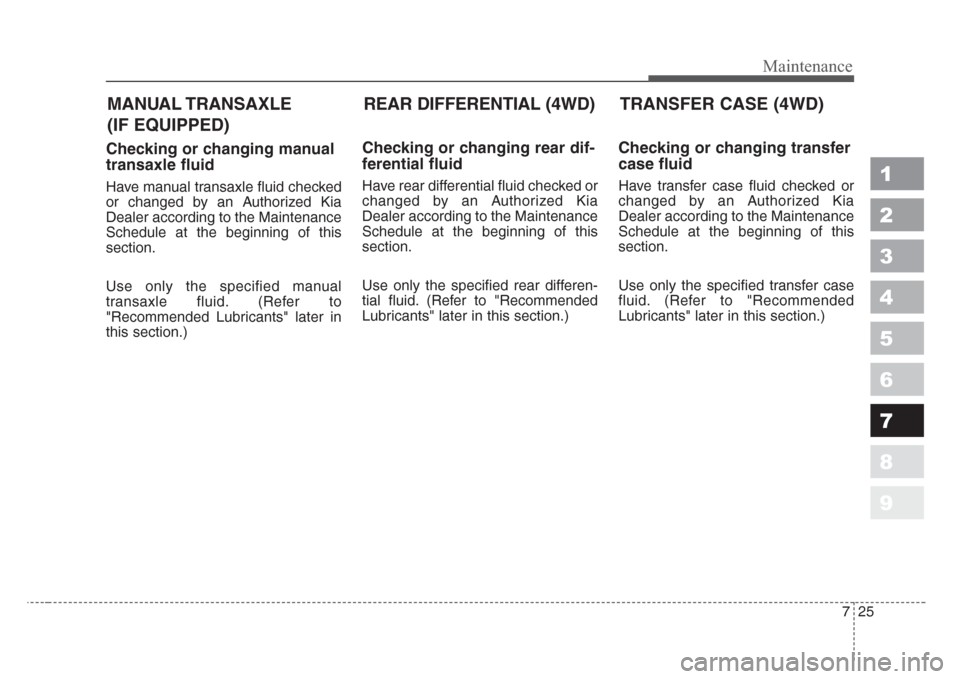Page 305 of 350

Maintenance
18 7
1
2
3
4
5
6
7
8
9
BRAKES AND CLUTCH (IF EQUIPPED)
Checking brake/clutch fluid
level
Check the fluid level in the reservoir
periodically. The fluid level should be
between MAX and MIN marks on the
side of the reservoir.
Before removing the reservoir cap
and adding brake/clutch fluid, clean
the area around the reservoir cap
thoroughly to prevent brake/clutch
fluid contamination.If the level is low, add fluid to the
MAX level. The level will fall with
accumulated mileage. This is a nor-
mal condition associated with the
wear of the brake linings. If the fluid
level is excessively low, have the
brake system checked by an
Authorized Kia Dealer.
Use only the specified brake/clutch
fluid. (Refer to “Recommended
Lubricants” later in this section.)
Never mix different types of fluid.
WARNING - Brake fluid
When changing and adding
brake/clutch fluid, handle it
carefully.Do not let it come in
contact with your eyes.If
brake/clutch fluid should come
in contact with your eyes,imme-
diately flush them with a large
quantity of fresh tap water.Have
your eyes examined by a doctor
as soon as possible.
WARNING - Loss of brake
fluid
In the event the brake system
requires frequent additions of
fluid, the vehicle should be
inspected by an Authorized Kia
Dealer.
1KMN5020
Page 306 of 350
719
Maintenance
1
2
3
4
5
6
7
8
9
✽
NOTICE
Do not allow brake/clutch fluid to
contact the vehicle's body paint, as
paint damage will result.
Brake/clutch fluid, which has been
exposed to open air for an extended
time should never be used as its
quality cannot be guaranteed. It
should be thrown out. Don't put in
the wrong kind of fluid. A few drops
of mineral-based oil, such as engine
oil, in your brake clutch system can
damage brake clutch system parts.
Checking the parking brake
Check the stroke of the parking
brake by counting the number of
“clicks’’ heard while fully applying it
from the released position. Also, the
parking brake alone should securely
hold the vehicle on a fairly steep
grade. If the stroke is more or less
than specified, have the parking
brake adjusted by an Authorized Kia
Dealer.
Stroke : 7~8 “clicks’’ at a force of
20 kg (44 lbs, 196 N).
1KMA3050
PARKING BRAKE
Page 307 of 350
Maintenance
20 7
1
2
3
4
5
6
7
8
9
DRIVE BELTS
Checking the compressor
drive belt
Have the drive belts checked in
accordance with the maintenance
schedule.
2LDA7002/1KMA7025 ➀ P/S pump pulley
➁ Water pump pulley➂ A/C compressor pulley
➃ Generator pulley➄ Crankshaft pulley
2.0L Gasoline Engine 2.7L Gasoline Engine
➀➀
➃
➃ ➁
➄➄ ➂
➂
Drive belts should be checked periodically for proper tension and adjusted
(2.0L only) if necessary. At the same time, belts should be examined for
cracks, wear, fraying or other evidence of deterioration and replaced if nec-
essary.
Belt routing should also be checked to be sure there is no interference
between the belts and other parts of the engine. After a belt is replaced, the
new belt should be adjusted again after two or three weeks to eliminate slack
resulting from initial stretching after use.
Page 308 of 350

721
Maintenance
1
2
3
4
5
6
7
8
9
POWER STEERING
Checking the power steering
fluid level
With the vehicle on level ground,
check the fluid level in the power
steering reservoir periodically. The
fluid should be between MAX and
MIN marks on the side of the reser-
voir at the normal temperature.
Before adding power steering fluid,
thoroughly clean the area around the
reservoir cap to prevent power steer-
ing fluid contamination.
If the level is low, add fluid to the
MAX level.In the event the power steering sys-
tem requires frequent addition of
fluid, the vehicle should be inspected
by an Authorized Kia Dealer.
✽
NOTICE
• To avoid damage to the power
steering pump, do not operate the
vehicle for prolonged periods with
a low power steering fluid level.
• Never start the engine when the
reservoir tank is empty.
• When adding fluid, be careful that
dirt does not get into the tank.
• Too little fluid can make the steer-
ing wheel heavier or strange noise
can be generated.
• The use of the non-specified fluid
could reduce the effectiveness of
the power steering wheel and
cause damage to it.
Use only the specified power steer-
ing fluid. (Refer to "Recommended
Lubricants" later in this section.)
Power steering hose
Check the connections for oil leaks,
severe damage and the twists in the
power steering hose before driving.
1KMN5018
Page 309 of 350
Maintenance
22 7
1
2
3
4
5
6
7
8
9
STEERING WHEEL
Park the vehicle on level ground,
start the car and place the tire
wheels in the straight-ahead posi-
tion. Turn the steering wheel to the
left and right with a little force and
check the free play until you get a
feel for resistance against the tire
wheels movement.
Standard value: 30 mm (1.2 in) or
less
✽
NOTICE
If the measured value exceeds the
standard value, have the system
checked by an authorized Kia deal-
er.
1KMA5019
30 mm
(1.2 in)
Page 310 of 350

723
Maintenance
1
2
3
4
5
6
7
8
9
AUTOMATIC TRANSAXLE (IF EQUIPPED)
Checking the automatic
transaxle fluid level
The automatic transaxle fluid level
should be checked regularly.
Keep the vehicle on the level ground
with the parking brake applied and
check the fluid level according to the
following procedure.
1. Place the selector lever in N
(Neutral) position and confirm the
engine is running at normal idle
speed.2. After the transaxle is warmed up
sufficiently (fluid temperature
70~80 °C (158~176 °F)), for exam-
ple by 10 minutes usual driving,
shift the selector lever through all
positions then place the selector
lever in N (Neutral) or P (Park)
position.
3. Confirm that the fluid level is in
“HOT” range on the level gauge. If
the fluid level is lower, add the
specified fluid from the fill hole. If
the fluid level is higher, drain the
fluid from the drain hole.
4. If the fluid level is checked in cold
condition (fluid temperature 20~
30 °C (68~86 °F) add the fluid to
“COLD” line and then recheck the
fluid level according to the above
step 2.
1KMN50511LDE5009 COLDHOT
Page 311 of 350

Maintenance
24 7
1
2
3
4
5
6
7
8
9
✽
NOTICE
“COLD” scale is for reference only
and should NOT be used to deter-
mine transaxle fluid level.
✽
NOTICE
New automatic transaxle fluid
should be red. The red dye is added
so the assembly plant can identify it
as automatic transaxle fluid and dis-
tinguish it from engine oil or
antifreeze. The red dye, which is not
an indicator of fluid quality, is not
permanent. As the vehicle is driven,
the automatic transaxle fluid will
begin to look darker. The color may
eventually appear light brown.
Therefore, have an Authorized Kia
dealer change the automatic
transaxle fluid according to the
Scheduled Maintenance at the
beginning of this section.
Changing the automatic
transaxle fluid
Have automatic transaxle fluid
changed by an Authorized Kia
Dealer according to the Maintenance
Schedule at the beginning of this
section.
Use only the specified automatic
transaxle fluid. (Refer to
"Recommended Lubricants" later in
this section.)
CAUTION
• Low fluid level causes
transaxle slippage.Overfilling
can cause foaming, loss of fluid
and transaxle malfunction.
• The use of a non-specified fluid
could result in transaxle mal-
function and failure.
WARNING- Parking brake
To a v oid sudden movement of
the vehicle, apply parking brake
and depress the brake pedal
before moving the shift lever.
WARNING -Transaxle
fluid
The transaxle fluid level should
be checked when the engine is at
normal operating temperature.
This means that the engine, radi-
ator, radiator hose and exhaust
system etc., are very hot.
Exercise great care not to burn
yourself during this procedure.
Page 312 of 350

725
Maintenance
1
2
3
4
5
6
7
8
9
Checking or changing manual
transaxle fluid
Have manual transaxle fluid checked
or changed by an Authorized Kia
Dealer according to the Maintenance
Schedule at the beginning of this
section.
Use only the specified manual
transaxle fluid. (Refer to
"Recommended Lubricants" later in
this section.)
Checking or changing rear dif-
ferential fluid
Have rear differential fluid checked or
changed by an Authorized Kia
Dealer according to the Maintenance
Schedule at the beginning of this
section.
Use only the specified rear differen-
tial fluid. (Refer to "Recommended
Lubricants" later in this section.)
Checking or changing transfer
case fluid
Have transfer case fluid checked or
changed by an Authorized Kia
Dealer according to the Maintenance
Schedule at the beginning of this
section.
Use only the specified transfer case
fluid. (Refer to "Recommended
Lubricants" later in this section.)
REAR DIFFERENTIAL (4WD)TRANSFER CASE (4WD) MANUAL TRANSAXLE
(IF EQUIPPED)